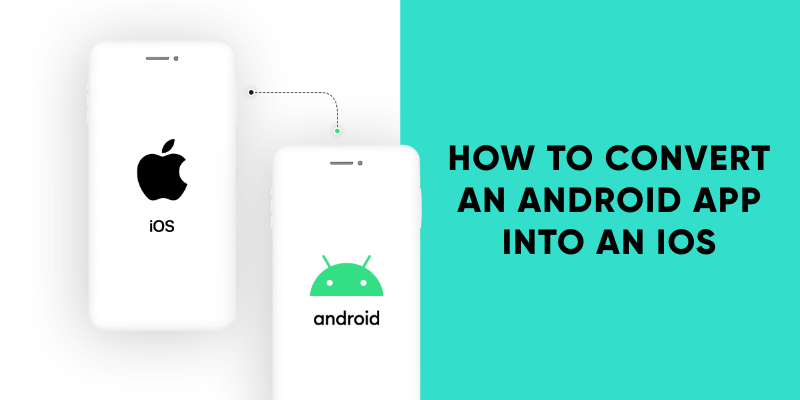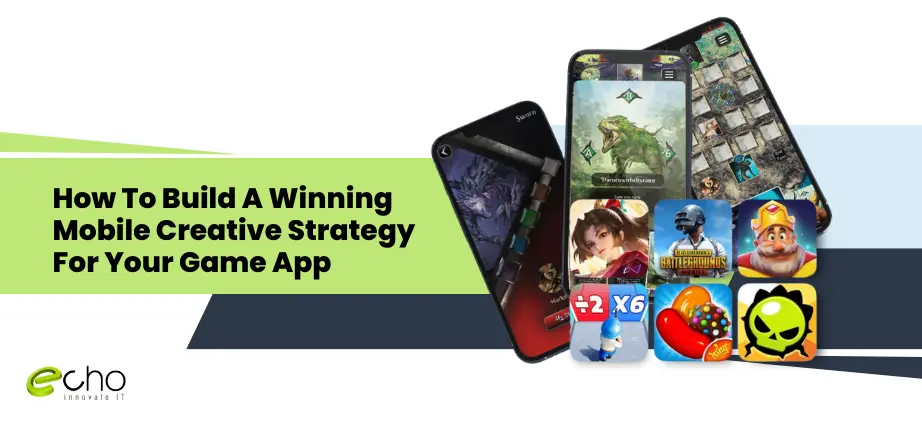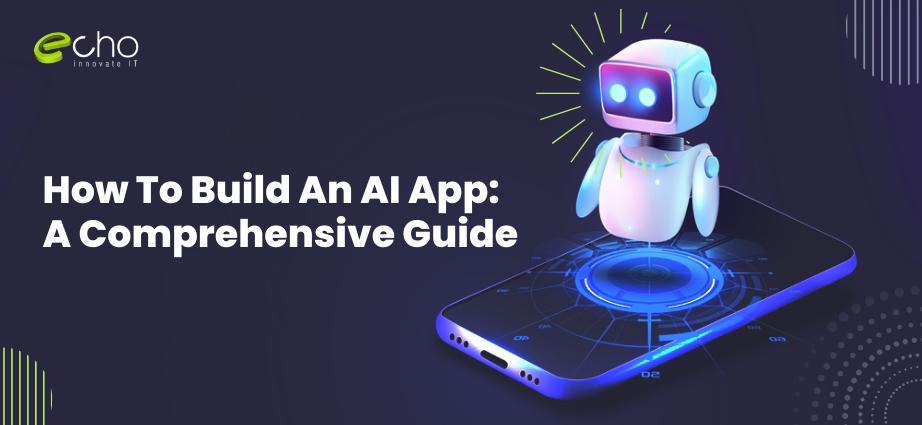Trying to Convert android into an iOS app but discovering that it’s not as simple as converting an Android APK to iOS?
Given the immense spending power of all those iOS users, it’s an obvious choice.
According to Statista, “Apple device users are significantly more likely than Android device users to spend money on or in apps.”
If you want to keep ahead of the competition, you should convert your Android app to iOS. This is something that Echo Innovate IT can assist you with. We’ve already assisted several businesses in developing world-class cross-platform Android and iOS apps.
In this article, we’ll show you how to convert android to iOS app so you can get the most out of your existing Android app.
Difference Between Android App And IOS Application
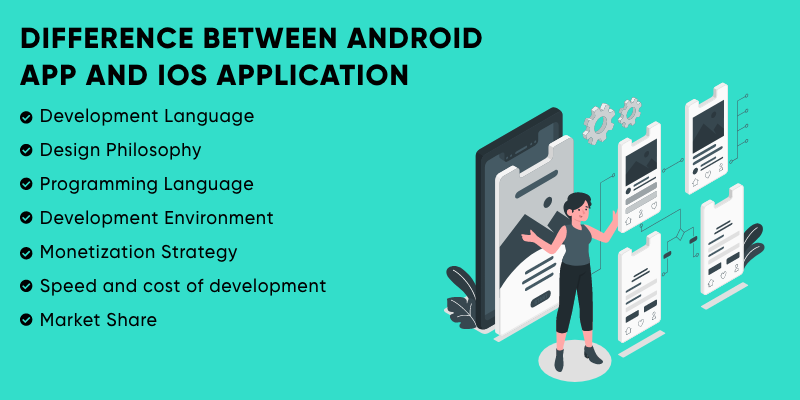
Development Language
When developing Android apps, Java is used. It necessitates the writing of a substantial amount of code. Swift is a brand-new programming language for creating iOS apps. Swift allows you to code significantly faster than Java. In comparison to Swift engineers, Java engineers need a lot more time to code. Swift was introduced in 2014, and it allows developers to create apps faster by writing less code.
There is a potential Java alternative in the form of the Kotlin coding language, which is fully compatible with Java. It was created as a Java language enhancement: it’s simple to use and read. Furthermore, Kotlin is currently widely regarded as the primary language for developing Android apps and you can hire the best Kotlin developers from Echoinnovate IT.
Also Read:
Design Philosophy
The following are some design principles to keep in mind when creating an app:
Apple’s iOS devices come in two sizes (iPhone/iPad) and a variety of resolutions (more than three for iPhone and a handful for iPad). The iPad uses the same resolution as the iPhone 4. Meanwhile, Google-backed Android-based equipment comes in a variety of screen sizes, resulting in a wide range of screen resolutions.
Navigation
The navigation bar for Android devices is on the left, whereas iOS devices are on the right. Colorful icons are preferred on Android, whereas iOS navigation icons are blue or grey by default.
Menu
Google-backed smartphones favor a drawer menu or a side/hamburger menu, which appears on the left after a tap-and-pull gesture, but iOS favors its tab bar, which appears at the bottom and provides considerably simpler access to hidden menu icons. The hamburger menu is very popular on iOS devices, but it should be customized.
Pop-ups and alerts
These tabs arise out of nowhere and require immediate attention. As a result, there are some slight differences between alerts and pop-ups. To avoid the notifications, Android users should choose “Agree/Disagree” or “Don’t allow/Okay” for Apple-supported users. For iOS devices, there are two sorts of alerts: alert and action sheet. They have the same appearance and functionality, however, an action sheet is used when more than two actions (including Cancel) are necessary.
‘Back’ button
The ‘Back’ button is used to return to the previous page. The Apple-backed platform lacks a functional ‘Back’ button, whereas the Google-backed platform has, allowing users to return to a previously visited page. iPhone users, on the other hand, can use the top left button to return to the previous screens in the hierarchy without having to navigate through the entire app.
Programming Language
Different technology stacks are used in iOS and Android programming. The first uses the Swift proprietary app development language, while the second leans largely on Java or Kotlin as an alternative.
Which stack is the quickest and most straightforward to master? Most mobile app developers believe that developing an iOS app is easier than developing an Android app. Because Swift is more readable than Java, it takes less time to learn how to code in it.
However, as Kotlin evolves, the tables may turn once more. The language is expected to replace Java shortly since it is intuitive, modern, and simple to read.
iOS programming languages have a lower learning curve than Android programming languages, making them easier to master.
Development Environment
The integrated environment is another significant difference between iOS and Android development.
Android developers use Android Studio, a Google-developed proprietary tool that debuted in 2013 and boasts a broader set of features. Cross-platform support, great readability, and a wide range of development and debugging facilities are all included in this integrated development environment.
iOS developers, on the other hand, use Apple’s XCode tool. The Apple-backed solution comes with several bug-fixing tools, is straightforward to use, and covers the whole range of iOS devices.
Monetization Strategy
Let’s look at the next factor, which is the majority of your audience, as an essential factor to consider when choosing an OS platform to build an app. Apple users are more likely to make purchases, whilst Android users are more likely to use ad-supported apps.
The two largest retailers, Apple’s App Store and Google Play, combined for roughly 26 billion downloads worldwide. App revenue surpassed $16 billion for the first time. According to Statista data, Google Play was the most popular app in the third quarter of 2017, with a 10% rise in downloads over the same period in 2016. Meanwhile, downloads from iOS-based devices increased by 8% over the previous quarter.
Consumer spending continues to rise around the world. In the third quarter of 2016, sales from Android and Apple Store apps combined reached more than $16 billion, up 28% over the previous quarter. In the third quarter of 2017, consumer spending on iOS was nearly double that on Google Play. However, because of year-over-year growth rates of over 25%, both stores saw unprecedented levels of consumer spending.
Speed and Cost of Development
In terms of OS fragmentation, creating an Android-based platform takes longer and is slower. Engineers take 30-40% longer to design an Android-powered mobile app than an iOS-based app. And this is even though the Java/Kotlin languages are not super difficult.
To determine how much it costs to create an app depends on the business objectives and demands, you must first choose a platform, select an app development company, and request a preliminary estimate. You should also keep in mind that the cost of app development is determined by the amount of time it takes to develop it. The cost also depends on the time taken for app development and the mobile app development company that you hire.
Market Share
Operating systems are utilized on a variety of devices, including smartphones, PDAs, tablets, and so on. They enable these gadgets to run apps and programs, allowing them to perform more advanced functions. In the smartphone business, the widely used operating systems (OSs) are Google’s Android and Apple’s iOS. In 2016, almost 1.5 billion phones running either an Android or an iOS operating system were sold to end customers around the world.
The statistic depicts the global market share of the top smartphone operating systems in terms of end-user sales. In the first quarter of 2017, Android-powered 86.1 percent of all phones sold to end customers.
Reasons To Convert Your Android App Into IOS
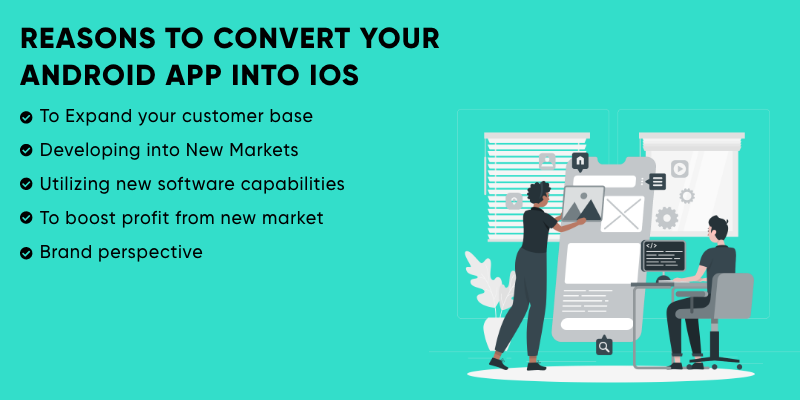
All reasons for porting an Android app to iOS simply come down to embracing an opportunity to expand into previously undiscovered, profitable areas for future growth in the global mobile software industry.
To Expand your Customer Base and Develop into New Markets
You might be overlooking Apple’s “flip side” of the market for no apparent reason. Even if you’re solely focused on Android, why not cater to both crucial market segments? Market horizons that have yet to be explored mean new market shares and additional users. Even though Android is a tremendously popular buyer’s option around the world, Apple’s devices still account for 54% of the market in the United States, 53% in Canada, and 53% in Oceania. The entire iOS market share in most other parts of the world can range from 20 to 40%.
If you want to target such a location or, in the best-case scenario, expand across it, you can’t pass up the opportunity to start operating in it soon after converting an Android app to iOS. For this, following the updates on iOS development is also important.
Utilizing New Software Capabilities
Converting an Android app to an iOS piece of software allows you to add new features to your product while also expanding it to meet Apple’s capabilities. Because the entire process of porting an Android app to iOS involves rewriting the program from the ground up, you have a lot of freedom to add or eliminate whatever features and capabilities you choose. You can even take the outcomes of a completely redesigned product and apply them to the Android version.
To Boost Profit from New Market
Despite accounting for a smaller portion of the worldwide market, iOS customers are significantly more willing to pay than Android users. Furthermore, instead of one app for each of the essential mobile platforms, covering the global market with two apps should help you generate more revenue. You effectively increase your marketing opportunities while also enjoying the rewards of previously unavailable market niches.
Brand Perspective
Apple has created a one-of-a-kind, exclusive market and user ecosystem that Android lacks. Its key advantage is that it applies to a wide range of user categories and demographics. Common iOS users are a distinct breed that requires special consideration. And developing a well-targeted strategy pays off handsomely in the long run. Given that the Macbook and iPad are rapidly moving to the Apple M1 processor, an Android application transferred to iOS is just the first step in a comprehensive product creation that includes the entire Apple product range.
What Things You Should Keep In Mind While You Convert Android Into IOS App?
- An Android device’s navigation differs from that of an iOS device such as an iPhone, iPad, or even an iPod. There are three buttons on Android phones: ‘Home,’ ‘Back,’ and ‘Multitasking.’ iPhones, on the other hand, feature only one ‘Main’ button.
- The ‘User Interfaces’ (UIs) on Android and iOS have various design techniques. The ‘Material design’ is used by Android, whereas the ‘Flat design’ is used by iOS. This is a crucial consideration when porting Android apps to iOS. The flat design is simple and does not include any graphics with 3D effects. The emphasis is on design functionality and ease of use. The material design, on the other hand, provides more versatility. Grid-based layouts, animations, padding, and responsiveness are all included. For a thorough explanation of the distinctions, see “What’s the Difference Between Flat and Material Design?”
- It’s important to remember the operating system version. For example, your application should work with the most recent version of iOS (iOS 10).
- These two systems have separate libraries and frameworks. As a result, you’ll need to research and identify tools, frameworks, libraries, and compatible services.
- Because the differences between the two platforms are major, you should extensively test your converted application. Incorporate integration, validation, “user acceptance testing” (UAT), and beta testing into your strategy.
- You’ll need to submit your program to Apple’s ‘App Store’ once you’ve finished testing it. You should read the “App Store Review Guidelines” carefully.
How To Convert An Android App Into An IOS App?

To get the finest final output, use a renowned mobile development company with competent developers and testers to convert the iOS app to Android. When working on platforms that use many languages, it’s a frequent misunderstanding that developers must intercept one language into another. That, on the other hand, is inaccurate. Switching to Android necessitates a development process.
Designers working on the migration of the iOS app to Android will need some time to get used to the server’s interactions. Because Android apps use XML, whereas iOS apps prefer JSON, designers must additionally consider the performance of the Java coding language, which is inferior to Objective-C.
Let’s Take A Look At A Few Key Points
Analyze App Requirements and Functionality
There are a few things to keep in mind while transferring an iOS app to an Android app. To understand your fast iOS app’s features and define workflow, you must conduct a thorough analysis. In the analysis, the following critical questions should be addressed:
- What are the app’s drawbacks?
- Determine the context for optimization.
- Learn how the back-end technology stack works.
- What third-party libraries are being used?
- Recognize the technology that was used to construct the app.
- Specification of Function
- Review of the Design
- Review of the Code
Analyze Technical and Business Requirements
This requires a thorough analysis of the app’s business logic, as well as compatibility issues with the iOS platform and third-party modules and libraries used by the Android app, as well as room for growth and optimization. It’s worth noting that Android and iOS apps share the same backend, which means the code that handles the business logic layer remains the same.
All of this should be organized according to the iOS platform’s quirks. It’s best to have a team of experienced software experts on your side to assist you in gathering all of the necessary data. At this point, you must normally evaluate:
- App design specifics
- Functional specification
- Business logic structure
- Source code nuances
Ultimately, you should look at the entire project from both a technical and a business standpoint. A Software architect and a Business analyst, respectively, can lay out the most appropriate parts to carry out vital functions in both fields.
A detailed market analysis, project mind-map, code and design review, workflow structure organization, and functional specifications are all critical stages here.
Customize the Design to Convert Android into iOS App
The user interface and layout must be changed to code an application from the ground up. Many people make the mistake of copying the existing user interface rather than altering it as an important item. Before making any changes to the design of your app, consider the following points. The metric differences must also be remembered and understood. Android screen resolutions vary, as do icon sizes, and the 480DP rule reigns supreme in UI design, among other things.
Icon and font sizes on the Apple platform are measured in points (pt) rather than pixels. The pixel-to-point ratio is around 0.75.
Rewrite the Code and Optimize Software Architecture
Because the Android app code cannot be simply recompiled to fit the iOS architecture, the majority of the software will need to be fully recorded. The most important thing is to maintain all of the compatibility in line and to make sure that every step of the process is in sync with the new platform requirements. Technical specialists are in charge of the majority of the work here (software engineers and designers). There is software that transforms Android (Java, Kotlin) code to iOS code (Swift). However, these automation methods produce code of poor quality, which necessitates extensive rewriting and optimization by iOS engineers.
You’ll need to implement several third-party integrations into your solution, including:
- A payment gateway (multiple ones, like Stripe and PayPal, would be best);
- Social integrations with the most popular platforms (Facebook, Instagram, Twitter, LinkedIn, etc.);
- Data analytics modules (including Google Analytics, Mixpanel, and others);
- Order delivery integrations.
The rest of the code porting procedure is spent refining and implementing assets one by one, ensuring that the workflow is flexible enough to handle all of the project’s important stages as well as any additional work elements that may arise.
Testing, Q&A, and Release
To successfully port iOS software to Android, development teams will need to do extensive quality assurance. Both during the design and development phases, mobile app testing is jeopardized. It consists of the following steps:
- Integration testing of software modules (individually and as a group
- Validation testing: assessing if the completed software solution meets business requirements.
- Testing of user scenarios.
- Beta testing with real-time data analysis is required before the final release (by users and a client).
The rest of the code porting procedure is spent refining and implementing assets one by one, ensuring that the workflow is flexible enough to handle all of the project’s important stages as well as any additional work elements that may arise.
Cost Estimation To Convert Android Into IOS App
A small project’s minimum cost is $3000. The cost to convert android into iOS app is entirely determined by the complexity, size, and features of the app. For the average feature app, your budget should be between $6000 and $20000. Keep in mind that the pricing is determined by all of the parameters stated below.
The following considerations should be considered when determining the cost of conversion:
- Programming Languages used
- System Frameworks
- User Interface (UI) design
- APIS
- Software Development Kits (SDKs)
- App’s interaction with the device hardware
- Types of devices and Android version supported
Conclusion
To convert android into iOS app is a serious undertaking that necessitates a complete software redesign, enhancement, and optimization endeavor to take on the previously unavailable market territory. This fairly difficult task, however, pays off in the long term, as you gain access to a new paying user base in the most exclusive market segment currently available.
Echoinnovate IT is one of the leading mobile app development companies with over a decade of experience that can assist and guide you with everything. So, get in touch with our experts now!
FAQs
How long does it take to convert an app?
It can take up to 1- 6 months. But the timeline depends on the complexity of the application, features included and frameworks, design, and others.
Can you convert an Android app to iOS?
It is feasible to convert an Android app to an iOS app, even though the two operating systems have different application frameworks and regulations. The approach, however, necessitated a degree of skill and expertise that not many developers possess. Companies without prior experience should engage developers who are familiar with the Android to the iOS conversion process.
How to convert an Android app to iOS?
Converting an Android app to iOS will vary in difficulty depending on the complexity of your application. If you want to be successful, everything from the UI adjustments to ensuring that all components of the converted app meet Apple’s high requirements is important. This is why it’s critical to hire experienced Android and iOS developers.
